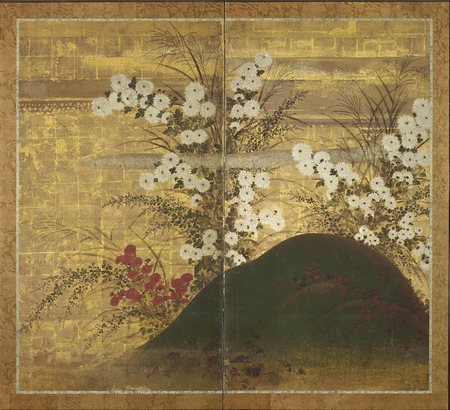Product Description
6942 A two-fold paper screen painted in ink and colour on a gold ground with kiku (chrysanthemum) and autumn plants behind a grassy knoll. The kiku petals are rendered in moriage (raised design), and a mist of sunago (sprinkled gold dust) drifts amongst the flowers.
Seal: Inen
Rimpa School, Japan 17th century Edo period
Dimensions: H. 163cm x W. 178cm (64¼” x 70¼”)
Published in Rimpa Painting Volume II: Seasonal Flowering Plants and Birds, Kobayashi Tadashi; Shikosha, 1990, pl.289.
The ‘Inen’ seal is regarded as a trademark of the Tawaraya workshop, led by Tawaraya Sōtatsu (died ca.1640), who co-founded the Rimpa school with Hon’ami Kōetsu (1558–1637). Sōtatsu is known to have used the ‘Inen’ seal himself, although only until he was granted the honorary title of Hokkyō in or around 1624. Hokkyō literally ‘Bridge of the Law’, is the third highest honorary title, initially bestowed upon priests and then from the 11th century on Buddhist sculptors. From the 15th century the title was also given to artists. Around 1620 the leading pupil of the Tawaraya workshop was given the “Inen” seal by Sōtatsu and is referred to as the ‘Painter of the Inen seal’.
Early Japanese records suggest that kiku (chrysanthemum) were introduced from China in the pre-Nara period (pre-710), with the focus at that time on the plant’s medicinal uses. Various varieties of the plant are still used today in Asian herbal medicine to detoxify the body and treat fever, liver problems and eye disease.
By the Heian period (794-1185), kiku were cultivated as ornamentals, but the plant’s prophylactic qualities were still celebrated. In the Edo period (1615-1868), the Choyo Festival was made one of the officially recognised seasonal Five Festivals. This autumn festival is held on the ninth day of the ninth month and because this is the season in which kiku flourishes, it is also called the Chrysanthemum Festival. During the Edo period, beginning with each daimyō, people gathered at Edo Castle, held a Choyo ceremony and celebrated it with kiku sake, wine in which kiku petals had been steeped. Court nobles also rubbed their bodies with the night dew of kiku as it was believed to deter evil spirits and to prolong life.
Kiku viewing was also a pastime for people living in Edo. The Edo period was a time when gardening boomed and from the early Edo period, as enthusiasm for gardening grew, different types of various species were produced and flower shows for new types of kiku called kikuawase (chrysanthemum matching) were also held amongst the people.
Japanese interest in kiku as a theme for poetry developed during the Heian period. At that time, with the evolution of a native artistic sensibility heavily influenced by the passing seasons, the flower gained its place as one of the premier symbols of autumn. In many instances, kiku appear in ensemble motifs with all or some of the Seven Grasses of Autumn, and it is sometimes included in enumerations of this group.
The first use of kiku as a symbol of the Japanese imperial family occurred in the thirteenth century. Later many commoners also used the flower as a family crest, and a Matsuya store catalogue of 1913 included ninety-five crest designs based on kiku.






